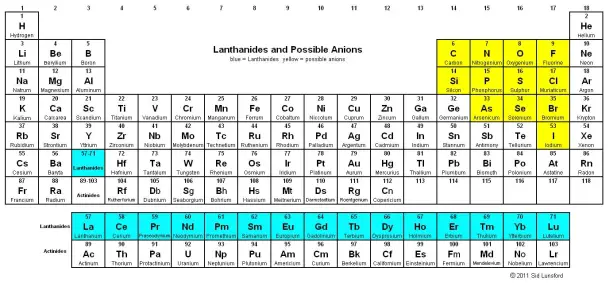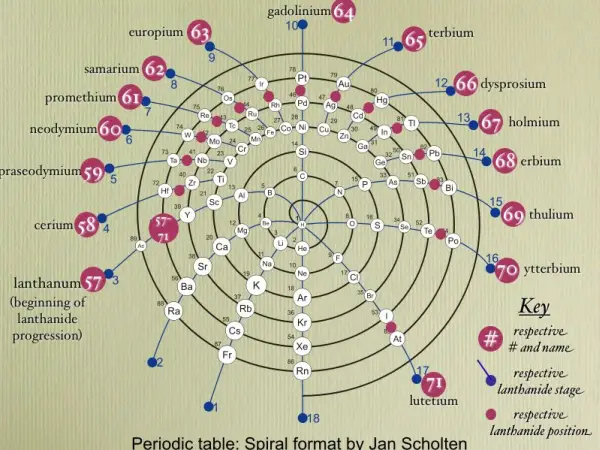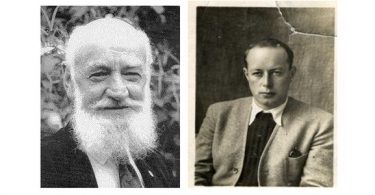Aphorism 119 . . . “As certainly as each mineral and each salt . . . differs from each other; just as certainly are they all different and divergent from one another in their morbific and curative actions . . .”
Samuel Hahnemann described the healthy human state as culminating in the ‘freedom to pursue the higher purposes of one’s existence’. Similarly, more than 100 years later, Abraham Maslow popularized the term self-actualization, defining it as ‘the full use and exploitation of one’s talents, capacities and potentialities’. If disease implies a degree of limitation to realizing one’s fullest potential, then homeopathic remedies carry a solution to that limitation. And for complaints specifically relating to self-actualization, the Lanthanide remedies are especially useful.
With atomic numbers ranging from 57 to 71, the Lanthanides lie beyond silver (47) and precede gold (79), and are usually printed near the bottom of the most common periodic tables. More precisely, they’re a subset of elements “hidden” in the third column of the sixth horizontal row. The full homeopathic significance of this position becomes evident through Jan Scholten’s explanation of the framework of elements surrounding the lanthanides, first articulated in his book “Homeopathy and the Elements” and then expanded upon in “The Secret Lanthanides”.
To review, Scholten was a former chemist turned homeopath who recognized themes of homeopathic indications with increasing elemental weights. He described how the 4th, 5th and 6th horizontal rows (or “series” of elements) reflect dilemmas related to one’s “performance” in life. The 4th row includes cuprum, which is task-oriented: “delusion he is selling green vegetables”. This row is also known as the Copper (or iron) series. The 5th row includes argentum, and relates to gifts of speech and writing, creative expression, new ideas, and reflecting well to others. This is known as the Silver series. The 6th row includes aurum, and relates to power, influence, and heightened responsibility—one holds oneself to a “gold standard” in which reflecting well to others is not enough. And this is known as the Gold series.
Progressing from the left to middle according to vertical columns of the table, Scholten recognized an “ascent” of elements reflecting progressive confidence and challenges. One’s confidence culminates in the peak performance of niccolum and cuprum–10th and 11th columns of the Copper series; palladium and argentum of the Silver series; and platina and aurum of the Gold series. Similarly, he recognized how the 12th vertical column of zincum, cadmium and mercurius marks the beginning sense of decline—the first signs of waning competency and capacity. This decline continues with the subsequent elements, and progresses all the way to the right of the table.
To one degree or another, everyone is engaged in a performance in life, so a remedy from the periodic table is not chosen solely on that basis. For example, just because a person is a musician is not an automatic reason to look to the silver series for a remedy. Rather, the client needing a performance remedy may either directly state or imply that their performance is not freely expressed. Instead, it’s “conditional”—that is, their desire to refine their performance reflects a conditional standard by which they either feel “okay” or not. In other words, the performance may reflect their sense of self-worth, value, feeling nurtured and connected, feeling appreciated, being noticed, avoiding blame, etc.
How does the above relate to Lanthanides? Positioned at the 3rd column of the periodic table, Lanthanides represent the first steps towards autonomy and self-actualization. Venturing beyond challenges with relationship (1st column) and external structure (2nd column), the 3rd column marks the beginning of autonomous action, and is accompanied by confusion, irresolution and indecision. All Lanthanides also sit between silver and gold—symbolic of one’s desire to express silver gifts towards a golden ideal.
Dilemmas related to self-actualization are often expressed by words and phrases such as being ‘stuck’, ‘in a rut’, ‘trapped’, or ‘confused about the next step’. In other words, the person describes a frustrated desire for true and meaningful self-expression, to more fully express one’s inner gifts, and to be a more positive influence and make a bigger difference in the world. There are also histories in which this problem is not immediately recognized or articulated by the client; but the homeopath sees that the client is inhibited in their self-expression, and by extension the higher expression of their gifts is thwarted. The client desires to direct their gifts towards making a positive influence in the world, whether through their interpersonal interactions or their role in life–and yet they’re repeatedly stymied in their efforts to do so.
Once the theme of thwarted self-actualization becomes apparent, the next step is to decide which Lanthanide to choose. This step is achieved by getting a sense of one’s confidence in relation to more “mundane” tasks. For example, the client can be asked ‘how is your confidence with respect to a new challenge?’ The answer is a reflection of their confidence relative to their latent gifts and potential–the often sub-conscious sense of their inner capacity.
Discerning the client’s level of confidence can be challenging, because the homeopath will hear two co-existing threads of confidence. The confusion and indecision of the 3rd column is demonstrated indirectly by the person’s dilemma with self-actualization. Because the Lanthanides sit beyond silver, the person may not have any qualms with respect to public performance. They may be fully confident with respect to their innate talents, but their work never seems to meet the light of day. Or they could be working in jobs with high responsibility, and yet they relate a deep dissatisfaction with their work.
The choice of the particular lanthanide can be further complicated if the lanthanide is bonded with an anion which also embodies confidence issues, i.e., silica (“low” confidence) and sulphur (“high” confidence). But with careful discrimination one can distinguish the person’s confidence related to their inner capacity (lanthanide stage) as opposed to the confidence issues related to the anion. For example, sulphur is related to the ego’s need for appreciation, whereas silica is related to uncertainty about how they’re being perceived by others.
So the client’s level of confidence with respect to their inner capacity for more mundane tasks (or at least what they perceive to be mundane!) determines the homeopath’s choice of the particular lanthanide. Although the Lanthanides hold the 3rd column position, they also stretch horizontally, with each respective Lanthanide aligned with the vertical columns of remedies above them. For example, gadolinium is in the 10th column with niccolum, palladium and platina. The homeopath may hear the sense of one’s self-confidence being stymied (3rd column) but may also hear the strong confidence of peak performance with the sensitivity to not being appreciated (10th).
______________________________________________
Progression of Lanthanide themes:
Lanthanum (3rd): Confusion, irresolution, indecision in action, including new challenges on a relatively mundane level
Cerium (4th): Temporary plans develop, but usually change before any significant efforts have begun.
Praseodymium (5th): A feeling of needing to be “so much more” than one perceives oneself at present, and as efforts are made towards tackling a challenge, they seem to ultimately collapse—a frustrating feeling of 2 steps forward, two steps back.
Neodymium (6th): Anxiety with new challenges; a sense of “sink or swim”, that one is forced by circumstances to act even though one’s preparation feels incomplete.
Promethium (7th): Desire to gather facts from all available sources to gain control over a situation and ultimately insure success. Desires the team approach to solving problems.
Samarium (8th): Tackles challenges voluntarily as a means of testing one’s capacities. Once the sense of challenge is gone, the person may move on to other challenges.
Europium (9th): No longer needing to test one’s strength; what one lacks in capacity is compensated for in terms of sheer perseverance. A sense of “crawling through the desert” to reach one’s goal.
Gadolinium (10th): Conscientious about the final details of perfection; sensitivity to not being acknowledged or appreciated for one’s talents.
Terbium (11th): Full confidence in one’s inner capacities and talents (but nevertheless thwarted in their full outer expression).
Dysprosium (12th): Anxiety with respect to one’s slipping capacity for every manifesting one’s gifts. What one previously accomplished in a mundane capacity takes much more effort.
Holmium (13th): A definite sense of compromise with repeated efforts to return to past performance capacity; a temporary return is followed by slipping back to the state of compromise.
Erbium (14th): A feeling of emptiness, going through the motions, a hopelessness that one will ever return to a state in which expression of one’s gifts might be possible.
Thulium (15th). Sentimental about one’s past; clinging to memories of a time when circumstances might have allowed for one’s greater influence.
Ytterbium (16th) The dream of potential influence exists only in theory—‘if things had been different, those gifts could have changed the world’
Lutetium (17th) All hope for potential influence has died, but nevertheless residual “last- stand resistance” to accepting the present reality remains.
After recognizing the particular column of confidence and respective Lanthanide, one needs to understand what “hangs in the balance” between a successful or “failed” performance. If the client speaks of gaining or losing personal value, self-worth, or the potential for generating or losing general value (i.e., money), then one could consider carbonicum as an anion, because carbon holds a central place in our world in relation to generating value (e.g, building carbon chains in photosynthesis) or losing it (burning carbon fuels). Or if the person speaks of the fear of punishment, consequences for having done wrong or being perceived as having done something wrong, then one can consider bromatum. Other anions may be confirmed through their miasmatic qualities or keynotes.
As with any other salt (e.g., elemental compound), at times the anion (latter part of the compound) will be recognized first, and at other times, the cation (i.e, Lanthanide—the first part) is seen first. And at times the themes of cations and anions overlap (e.g, desire for appreciation with gadolinium or sulphur). Therefore, all Lanthanide salts are distinguished by very subtle differences, and one must be sure the gestalt of the salt is consistent with the total symptom picture. In other words, one should be very confident about the cation or anion (whichever is perceived more easily), and then work from that perspective to understand the other half of the compound.
Selected Anion themes:
Arsenicum; Cold, fastidious; anxious emphasis on gaining or losing security
Bromatum; Avoiding persecution, punishment, embarrassment
Carbonicum; Value and worth in relation to productivity; general and personal
Fluoratum; Syphilitic tendencies; superficial appearance/connection, hidden decay.
Iodatum; Warm; high metabolism and activity
Muriaticum; Connection/disconnection; nurtured/not nurtured, disappointment
Nitricum; Anticipatory anxiety; fear of high, narrow and “out of control” situations
Oxydatum; Sensitivity and imaginary fears; inspired/inspiring; may feel victimized
Phosphoricum; Sensitivity with imaginary fears related to dark, thunderstorms
Silicatum: Cold, sensitivity to criticism, desire to reflect a fixed image to others
Sulphuricum; Runs warm, disorderly, censorious, ego, desire for appreciation
One final consideration–at the far right of the horizontal rows are Noble Gases, signifying a limbo-like dormancy between the completion of one stage of life and the beginning of the next. The language of Noble Gases can at times be confused with Lanthanides, but is distinguished by the fact that these remedies have gaseous qualities of very strong sensitivity to the environment, as well as problems with bonding and sense of separation from others. One may also hear themes of past and present, relating to the elements on either side of the gas. Chemically, the Noble Gases, whose outer electron shell is complete and hence do not bond with other elements, may be better understood by viewing the periodic table in a spiral format, which helps to clarify their atomic position between the elements preceding and following them.
To summarize, in recognizing a Lanthanide theme in practice, one may perceive:
1)mineral language—through words in the history indicating structure and order
2)a performance theme—one is hoping to refine or express their “performance”
3) “silver gifts” which the client wants to manifest in a “golden ideal”—to be “good as gold”, but for various reasons the full expression is thwarted.
The homeopath must then determine the client’s relative degree of confidence with respect to mundane challenges. This gives an indication of how confident they are relative to their inner potential, and in turn, determines the particular Lanthanide indicated for the client’s state.
Finally, the homeopath needs to understand the significance of the performance to the client. A client might say ‘I want my music to make a difference in the world, but it seems like only friends and relatives show up when I perform, and that makes me feel worthless’ (carbonicum?). Or ‘I want my vision of enlightened architecture to someday help preserve the world’s resources—I feel frustrated that people aren’t listening–I don’t feel acknowledged or appreciated’ (sulphuricum?). Or ‘I want my stories to inspire children through a universal language of peace—yet as hard as I work at it, I’m not any closer to realizing my dream—that makes me feel deeply disappointed and alone’ (muriaticum?). In most cases, the anion also contributes to the understanding of how, and perhaps why, the lanthanide state is persisting for the individual.
In summary, Lanthanide remedies possess an amazing precision by which they match dilemmas of self-actualization. The above is an introductory guide to their use, and once the key to unlocking their use is found, they’ll likely become an essential part of one’s practice, as they unlock the clients’ gifts as well.
Ed note: This article was originally published in the American Homeopath 2011.
See David Johnson’s Lanthanide (Terbium) case in this issue.







Thank you so much for good article……
You’re welcome, Dr. Kalathia. I’m glad you liked the article.
Dear David!
I bough Schollten’book about lanthanides, but now, with your explanation, in a few pages, it was possible for me to undestand this ‘hidden’ fantastic elements. The Terbium case completed the understandintg.
Thank you very much. Warm greetings – Edson
Thanks for the feedback, Edson. The article provides an introductory framework re: how lanthanides can be discerned in practice, and then our clients teach us the rest!
DEAR DR,
YOU HAVE EXPLAINED LANTHANIDES VERY WELL. I WOULD LIKE YOU TO TELL US WITH CITING CASES CURED BY YOU IN YOUR PRACTICE BY APPLICATION OF THESE ELEMENTS
THANKS AND REGARDS
DR SHEKHAR
Thanks Dr. Shekhar, there is one case in this e-zine about terbium nitricum, but in the future I’d be happy to submit more. In my practice the lanthanides are just as common, if not more so, than the remedies in the copper, silver and gold series.
Wonderful,awaiting more matters regaring Actinides,
Will do!–as soon as I have a good grasp on them myself–
thanks..
You’re welcome–I hope the article is helpful to you and your practice–
Dave – Great article. Its like GPS for me on my travels in the periodic table. Your talks at Northwestern Academy of Homeopathy and this article are excellent.
Thanks for all you do, Sandra Jones
Thank you for the feedback, Sandra. Although the article tends to emphasize the lanthanides’ relationship to performance, recently I’ve seen how they’re helpful for self-expression in general, regardless of how “important” the role may seem in the culture. That is, lanthanides can be considered for a person who tends toward heavier self-reproach, who doesn’t always accept others’ positive feedback, and who’s experiencing some kind of block with expression in general (‘I don’t have a voice; I’m not heard; I’m not satisfied with my life right now’). By realizing greater personal and interpersonal self-expression, in turn the person experiences a greater sense of purpose and satisfaction in whatever role they choose to play.
David,
The heaviness and power required to turn intent into actualisation feels more like a Gold Series thing.
Feel like the Lanths give space for reflection, being a little lighter.
S.
P.S. Stephanie, I’m sorry if I misunderstood your post. The way I distinguish the 3rd column lanthanides (57-71) from gold series (i.e., ~72 onward) is that with the former there’s some block (e.g., confusion, irresolution, indecision) related to expression of one’s inner capacity, while the latter have defined and are actively engaged in autonomous “gold” expression: either aspiring to, engaged in, or wishing to return to full expression of that capacity. So yes, I agree there’s a slightly lighter feeling with the former, and a heavier feeling with the latter, even though I’ve seen the potential for fairly heavy depression in both groups.
Yes, but not much lighter. They’re part of the gold series–
Dear Sir
I want to purchase Lanthanides remedies.Please help me where can i purchase ?
Nearly all of the various lanthanide remedies can be obtained through Remedia pharmacy in Austria, Helios pharmacy in England, or Freeman’s in Scotland. Although Remedia has the most complete selection, some of the remedies it doesn’t have are available through the other two pharmacies.
Good luck!
Hello Dr. Bhandary,
Nearly all of the various lanthanide remedies can be obtained through Remedia pharmacy in Austria, Helios pharmacy in England, or Freeman’s in Scotland. Although Remedia has the most complete selection, some of the remedies it doesn’t have are available through the other two pharmacies.
Good luck!
Thank you for the precious insight David!
I’m reading Jan Scholten books about Elements and the Lanthanides as also Plant Kingdoms. From what I’ve understood is that people are born with a role and they play this role well until a trauma hinders them or block them (illness). Sometimes during life one can also switch a role, from a worker to a CEO, from iron to gold, but then circumstances change dramatically and these are a kind of trauma too if the person has not enough life force to cope with the stress.
But if a role is the implicit part of the person, his own mission, his root character, and circumstances like miasma, illness, trauma etc hinders that person to be what he really is, and then forced to play a role which does not fit to him or her, then illness is the result.
A Lanthanides person is a deep thinker, not superficial at all. His emotions are deep, his thoughts reach the deepest levels and so his role can be that of a scientist, artist or … homeopath. Indeed I’ve read that the Lanthanides are medicine for the homeopaths and similar professions. This kind of person is bored by the classic medicine and not satisfied by their explanations. They desire autonomy in their work and thinking. These are also that kind of people who finds new ways, new paths and methods.
All in all I’m very curious to see what further development in future will be discovered.
Absolutely excellent and so easy to understand. Thank you. I am about to start taking Dysprosium Oxydatum after Sepia for a number of years (to good effect) and this has made it easy to understand.
Could you tell me where I can find more about the proving of Samarium Phosphoricum please?
Thanks!
This is such a fascinating article and describes one of my family members so well. I just ordered your book – thank you so much for sharing this information.